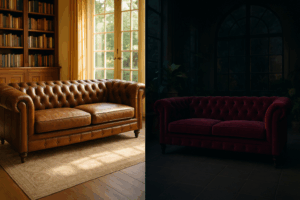Chesterfield Wiki
Official wiki of Chesterfield information
Selecting the perfect Chesterfield sofa is a significant investment in both style and comfort. This guide will walk you through the essential steps to avoid common pitfalls, ensuring you choose a piece that not only looks magnificent but also fits your lifestyle and space perfectly.
Contents
Assess Your Space and Dimensions
Before falling in love with a specific design, the first and most crucial step is to measure your room accurately. A Chesterfield sofa is a substantial piece of furniture, and its grandeur can overwhelm a small space if not properly scaled. Consider the sofa’s length, depth, and height in relation to your room’s layout, doorways, and hallways to ensure a smooth delivery.
- Tip: Use painter’s tape to mark the sofa’s footprint on your floor. This visual guide helps you understand how much space it will occupy and how it affects traffic flow.
- Example: For a standard 3-seater Chesterfield, ensure you have at least a 90-inch wide space to accommodate it comfortably without cramping the room.
Choose the Right Frame and Construction
The longevity of your Chesterfield sofa hinges on its internal construction. A high-quality frame is the backbone of a sofa built to last for generations. Avoid frames made from particleboard or plastic, which are prone to warping and breaking over time.
Look for sofas constructed from kiln-dried hardwood, such as oak or beech. This process removes moisture from the wood, preventing it from cracking or twisting later on. The joints should be reinforced with dowels, screws, or blocks—steer clear of models held together solely with staples or glue.
Select Your Upholstery Wisely
The fabric or leather you choose defines the sofa’s aesthetic, feel, and maintenance requirements. This is where your personal style and practical needs intersect. Top-grain leather offers durability and develops a beautiful patina over time, while sumptuous velvet adds a touch of luxury and works well in formal settings.
- For High-Traffic Homes: Consider a high-performance fabric with a high Martindale rub count (over 25,000) for exceptional durability and stain resistance.
- For a Pet-Friendly Home: Leather is often easier to clean than fabric, but it can be scratched. Tightly woven fabrics like microfiber can also be a good, resilient choice.
Consider Comfort and Cushioning
The iconic deep button tufting of a Chesterfield is not just for show; it helps hold the filling in place. However, the type of cushion filling is what truly determines comfort. The two main types are foam and feather. High-density foam cushions provide firm, consistent support and retain their shape well. Feather-filled cushions offer a plusher, sink-in feel but require regular plumping to maintain their form.
Many high-end sofas use a combination of both—a foam core for structure wrapped in a feather layer for softness. Sit on different models to determine which level of firmness and support feels best for you and your household.
Conclusion
- Always measure your space meticulously before purchasing.
- Prioritize a solid hardwood frame for long-term durability.
- Select an upholstery material that suits your lifestyle and aesthetic.
- Test different cushion fills to find your ideal comfort level.
Read more at https://chesterfielddeals.com/category/chesterfield/what-should-i-consider-when-buying-a-chesterfield-sofa/
A Comprehensive Guide to Chesterfield Sofa Styles
Leather vs. Fabric: Choosing Your Chesterfield
Essential Care Tips for Your Chesterfield Sofa
Hoe kies je de perfecte Chesterfield banken?
Waar moet je op letten bij het kopen van een Chesterfield bank?

